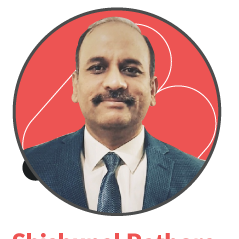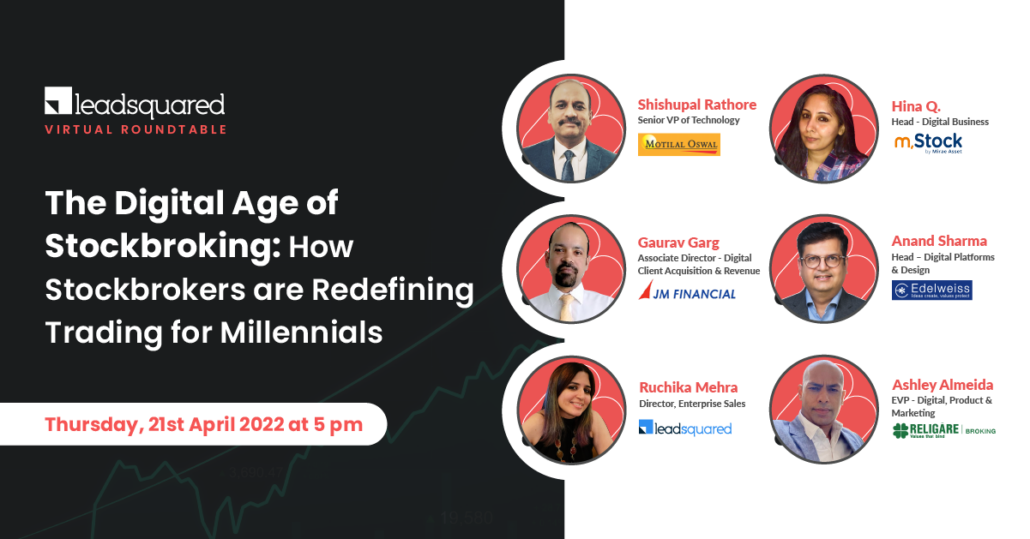Digitization has radically shaped the Indian financial markets, including stockbroking. While traditional or full-service brokers have always enjoyed a dominant presence and preference among investors, a demographic shift towards technology has given rise to discount brokers.
In this roundtable, we will discuss how the adoption of different, innovative technologies will redefine the core of the broking industry.
Panel:
- Gaurav Garg, Associate Director – Digital Client Acquisition and Revenue, JM Financial Ltd
- Anand Sharma, Head – Digital Platforms and Design, Edelweiss Wealth Management
- Shishupal Rathore, Senior VP of Technology, Motilal Oswal Financial Services Ltd.
- Hina Q., Head – Digital Business, Mirae Asset Capital Markets Pvt. Ltd.
- Ashley Almeida, EVP – Digital, Product, and Marketing, Religare Broking Ltd
- (Host) Ruchika Mehra, Director – Enterprise Sales, LeadSquared
Key Discussion Points:
- The need to migrate to cloud-based systems to meet the spike in trading volumes and new account openings.
- How to offer higher accuracy, convenience, and a top-notch customer experience using the right technology.
- Catalyzing your business growth by ensuring seamless account opening and automating the integration of processes.
- How to leverage data and enjoy real-time analytics to uncover critical, relevant insights for faster and more improved decision-making.
You can watch the webinar in its entirety or read the takeaways below.
What are the upcoming trends in the Indian stockbroking market?
Do you see a complete DIY investment process, or a hybrid model will prevail?
Ashley Almeida: The fundamental reason why people open accounts is to make some kind of return. Therefore, it is important for the platform or broker to aid that customer to be able to make that return.
I’m not surprised 86% of millennials are looking for that kind of support.
Millennial users largely fit into two buckets:
- Either they don’t have time, or
- They don’t have the expertise
Therefore, brokers can provide insights to help them make better decisions. They can make it easier for them to identify companies worth investing in through analytical information, blogs, webinars, etc.
Brokers need to not only provide a more convenient platform, but also a platform that helps users in making good decisions.
Anand Sharma: The role of a broker is not limited to providing a platform to make transactions. It needs to evolve to advise and enable users with tools, data points, information, etc.
Whether it’s a discount broker or traditional broker, they started their business with transactional platform, where the advantage was on the pricing side. While the ability to transact is still there, they’ve started enabling their platform with other platforms in the FinTech industry, which are playing the role of an advisor.
Earlier, transactions were done by dealers or relationship managers. But today, individuals are doing transactions. This trend in stockbroking is here to stay. However, to take the investment decision, users will still rely on experts before committing their money for long term.
Hina Q.: I will not go by a DIY or hybrid model. I’ll talk about a new segment we have entered into. It is zero brokerage.
Pricing is a very, very important factor and I agree that irrespective of platform, advice is important. Whether it’s a DIY or hybrid platform, the advice will be available for the customer. It can be in the form of video or bite-size information, but it will be there.
What’s the stockbroking houses’ plan of action to attract more customers from tier two and three cities?
70-90% of the accounts opened in the last two years are primarily from non-metro, tier two, tier three cities.
Shishupal Rathore: Today, technology is available everywhere. With just a good internet connection and a mobile phone, you can literally trade from anywhere.
So basically, the issue is not about technology. It is more about building that awareness: how and where they should invest. It’s more like telling a wealth creation story: how we can build wealth in the short term and a long term.
You can tell that story and educate your customers through nudge or a soft recommendation. More and more customers are going to invest in the stock market. What they really need is awareness and advice. Once they feel more secure, they’ll be attracted more towards the stock market.
Gaurav Garg: Client servicing and client advising are the two criteria that would make stock market investment popular in tier three, tier four cities as well.
In rural India (Bharat), the smartphone penetration is still low. People don’t have the ecosystem for investing or trading in stock market. But technology, client servicing, and client advising go hand in hand. If client servicing and client advising are in place by the time technology reaches the rural India, our industry is in good hands, and we have a long way to go.
Making the platform and content available in vernacular languages will help increase penetration in tier two, tier three cities. Also, taking away the jargon, making it simpler for the layman will increase adoption.
Ashley Almeida, EVP – Digital, Product, and Marketing, Religare Broking Ltd
Hina Q.: Content is king, and the language is the way forward. The way you communicate your offerings will create an impact and you can definitely observe the penetration in tier two and tier three cities.
Anand Sharma: So far, the innovations in the finance sector are driven by technology guys (non-financial guys). It means they’re able to understand the pain points of a common man and making efforts to address them.
Once the investment opportunities are made simple, the market becomes very big. The future is really bright because we’ll see a lot of innovations. We’re just at the start.
How do Indian stock broking houses plan to provide a seamless FinTech experience to invest in global markets?
Shishupal Rathore: Many stock broking houses have already started integrating with global stock broking agencies. We can provide these services to customers in multiple ways. For example, directly transacting in the in the global stock market or buy a portion of that stock.
But it’s equally important to make customers aware of the pros and cons of investing in a global market. Because here, foreign currencies are involved. The change in currency value would impact the overall profit and loss of the customer.
The new generation of Gen Y and Gen Z are in the high-income group. If we help them make right investment decisions, there are lots of opportunities, which will also give them a global exposure.
Anand Sharma, Head – Digital Platforms and Design, Edelweiss Wealth Management
Gaurav Garg: Many people are not getting desired returns or losing money because of lack of visibility. By making overseas investment as easy as possible and investment research easily accessible will attract more people invest in global markets.
What are the pros and cons of direct investment versus the NSE IFSC platform?
Ashley Almeida: What’s more important is, irrespective of the platform, users must be made aware of risks, such as currency risks. At present, two distinct platforms are available for global and domestic investment. It would be more convenient for the user if you could bring both platforms together. Also, if the portfolios are showcased together, it can drive more traction.
Another aspect to consider is remittance of money. By making the LRS process seamless, reducing paperwork and making it quicker you can increase users’ interests.
How do brokers ensure an outstanding customer experience?
Hina Q.: Client experience starts from the time they register and decide to partner with us for investment or trading needs. You need to make them self-sufficient through digital assets and assistance. At the same time, you should be able to intervene when they need you.
We’ve been trying to achieve the same. Everything we build is keeping customer expectations and experience in mind. Every screen you’ll see in our app is extensively evaluated from that perspective. We’ve also optimized onboarding and orders such that users can do it in just a few clicks.
Customer servicing is yet another non-negotiable aspect. That is, they should be able to get in touch with you when they need you. We’ve tried multiple options—from one touch contact to self-help and AI. CX can make or break any digital platform or business.
From CX perspective, the overall performance of a mobile app is crucial. It should be intuitive and provide a consistent experience. While there are active traders on the app, most of the traders use the app only to look at their portfolio. Therefore, data consistency is necessary. The app performance and availability form the overall crux of the customer experience.
Shishupal Rathore, Senior VP of Technology, Motilal Oswal Financial Services Ltd.
Ashley Almeida: CX is sector agnostic. People do not expect an experience from the BFSI sector, their compare their experience across everything. Whether it’s Netflix, Amazon, Swiggy, or an BFSI app—they expect the same experience.
Gaurav Garg: I would like to talk about customer engagement. We started off with one-to-one engagement and people claimed their services to be truly personalized. Then, we moved to one solution for clients because everybody wanted to give same treatment to all the category of clients.
Customer data platforms will play a huge role in customer experience and hyper personalization and that’s going to be a big differentiator.
Anand Sharma: Mobile application or website are just the vehicle of dissemination of your company’s proposition. Actual experience is built via product design, customer service operations, and multiple functions of the organization.
Rather than just thinking of just CX, think of overall experience of a customer. All the systems, touchpoints should be connected. We should not limit our thought process to only what the customer sees. Think of the ecosystem that you’re creating. Every stakeholder is important in building a great CX.
What is the role of AIML in stockbroking and how brokers are leveraging it?
Ashley Almeida: Let’s say, we have a customer base of 1 million users. If we create segments for this large base, it will be huge. But think about it. Do we really need to put them into segments?
The answer is no. Because every customer is unique.
They can have different demographics, could be a trader, an investor, or both. Basically, the nature of every customer is different. It is impossible for humans to cater to every individual requirement. And this is where you need machine learning.
For example, let’s say people who are holding TCS stock have also bought Infosys. So, now, we can recommend Infosys to the people who are holding TCS. AIML can help you understand customer behavior at an aggregate level and take it down to an individual level. It can nudge users with lot of insights to help them make good investment decisions.
Gaurav Garg: We’re going to use AIML in customer data platforms. It can help a lot in meaningful customer engagement.
The second use case is the conversational AI, which is more practical. A lot of AMCs and insurance companies are utilizing conversational AI to pitch insurance to their existing customers. It is increasing business for them.
How are stockbrokers handling the issue of information overload for customers?
Shishupal Rathore: Indeed, millennials and Gen Z are overloaded with information. But what’s more important for any customer, irrespective of the segment, is the ability to make a wise decision. Afterall, it’s their hard-earned money.
So, from our side, we can provide our perspective to the customers. It can be done through awareness sessions, educational videos, and more. The goal is to help them make a wise decision and build wealth.
Apart from this, sometimes, you need to lead customers through soft interventions and personalized advice or tips. However, we cannot push them into making an investment. It’s a high-risk market and everything is subject to market risk. So, ultimately, customers have to make the final decision.
Profile information can really add value. But it has to be very pointed information that consumers can easily consume and understand.
Hina Q., Head – Digital Business, Mirae Asset Capital Markets Pvt. Ltd.
Please shed some light on the adoption of cloud-based systems in the stockbroking industry.
Anand Sharma: Two years back, before Covid, we saw a surge in demands in the stock market. Handling scale was becoming difficult. Since, stock market is volatile in nature, you’d not want to invest in on-premise infrastructure instantly. At the same time, if you’re not ready to handle the scale, you’ll collapse.
Even though it sounds expensive initially, moving to cloud comes with a lot of flexibility. In fact, we’re 60% on the cloud. Cloud gives us flexibility to increase the capacity and manage costs. It is the way forward for us.
Shishupal Rathore: Cloud provides the flexibility to scale up and scale down without having to invest in the infrastructure. Secondly, the processing power of cloud technology is superior to their on-premise counterparts. Thirdly, from storage point of view, cloud-based solutions are very cost-effective.
So, cloud gives us a leverage from an overall cost, performance, scalability, and security perspectives.
Data security can be a concern, but we can ensure that through encryption and masking of sensitive data. We can keep the data on-premise, while data processing can still happen on cloud.
The only concern I see right now is the country’s regulations. But as far as we keep the data within the country (the data residency law), I don’t see a lot of concern with the cloud adoption overall.
How does your client acquisition strategy change with NSE’s recent circular on avoiding influencer programs for marketing?
Ashley Almeida: The bigger question is—have you grown because of influencers?
I don’t think the answer is yes. Because influencers only aid in disseminating the message or proposition of the broker. The absence of one medium gives space to several other mediums in marketing.
I don’t think avoiding influencer programs will have a negative impact on our customer acquisition strategy. However, brokers should focus on UTC (Unique Traded clients), the types of customers they’re onboarding, and how many of them are actually doing transactions on your platform. Because higher number of customers can only keep you happy for a certain amount of time. If you’re not getting the right customers, it’s not helpful for your business in the long run.
A lot of brokers give free ETFs to acquire new clients. But that’s not sustainable. By implementing this directive from NSE, only serious investor and traders will come in the picture.
Gaurav Garg, Associate Director – Digital Client Acquisition and Revenue, JM Financial Ltd
How do you see the trend of BNPL (Buy Now Pay Later) in the stockbroking industry?
Ashley Almeida: Some brokers, including us, have already launched BNPL. It is another way of looking at the margin trading product, where a customer only pays part of the amount and the rest of it is financed.
Hina Q.: This product is already available in the market and customer can leverage on that, specifically after there will be no regulations with regards to peak margins.
Audience questions
Gaurav Garg: Let me give you an example of zero brokerage. It is not actually zero. It is just the way pricing is presented. Even long-term investors have to pay DP transaction, DP AMC charges.
Somebody offering a brokerage in delivery segment or intraday segment, which is zero, eventually makes money from other segments. So, ultimately, it is not free, and there are ways to monetize these.
Hina Q.: So, it’s like you pay a one-time fee and then your entire brokerage is free across product. Of course, there will be government charges. From AMC perspective, there is only one-time AMC, and it is free for the lifetime. So, we can say, zero-discount broking and zero brokerage models are two different segments.
Ashley Almeida: People pay for value. Discount brokers offer unique proposition and value. But that does not mean that premium services cannot exist.
There are people who understand the value and are willing to pay the additional price. So, the question is—what I am bringing to the table and what is the client willing to pay. If the value proposition is good and priced right, then there’s definitely a revenue model you can think of.
Ashley Almeida: Yes, the traction for online is growing, but that does not mean that branches won’t exist. It’s because the branch experience is very different. There is an audience that loves to go to a branch, experience markets, talk to dealers, understands what’s going on, and then invest.
Traditional brokerage will exist, but at the same time, online trading will grow because that enables us to penetrate in tier two, three cities.
Anand Sharma: Traditional players who do not focus on technology to deliver the personalized advisory or RM driven, or advisor driven features or services will lose the competitive edge somehow. It’s true that technology is scalable. If someone expects relationship manager or advisor to be available, it may not be possible at the same rate. In that case, customers will have to pay for the value that person (advisor) brings to them. But when we think of scale, it will be through technology driven platforms.
Anand Sharma: I don’t think there is a limitation for a broker or advisory. I think all of them are different. Broking is a role where a person becomes member of exchange. There’s another role wherein research houses give advice on buying or having a target price or entry price for a particular spot. Then, there are RIAs (Registered Investment Advisor who are give advice to the customers.
The problem is if a broker is taking an RIA license, he cannot take revenue out of the brokerage. His revenue should come from RIA or a fee. However, research analyst and broker can come together. But RIA and broking coming together is a complex work.
Hina Q.: Communications about exchange, regulations, etc. should be built into the system and needs to be a part of the platform feature. The way you communicate is also important. Nudges, displaying information, etc. are really important, also for the customers to be aware of the platform features.
Gaurav Garg: SMS and emails are the most commonly used channels for communication. I think there’s a lot of scope of improvement in terms of utilizing different communication channels for better customer experience.
Speakers

Gaurav Garg
Associate Director – Digital Client Acquisition and Revenue, JM Financial Ltd

Anand Sharma
Head – Digital Platforms and Design, Edelweiss Wealth Management

Shishupal Rathore
Senior VP of Technology, Motilal Oswal Financial Services Ltd

Hina Q.
Head – Digital Business, Mirae Asset Capital Markets Pvt. Ltd.

Ashley Almeida
EVP – Digital, Product, and Marketing, Religare Broking Ltd

Ruchika Mehra
Director – Enterprise Sales, LeadSquared







